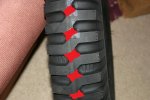1943ht
Active member
- 478
- 98
- 28
- Location
- Clermont Florida 34711
Installing a turbo in my M818 this week in anticipation of singleing her out in the near future (All ready have my new tires - Goodyears and wheels) .. A retired Marine Corp Buddy of mine with 30+ years of service as a Maintenance Chief is totally against the concept for that series vehicle .. here are just a couple of issues he brought to my attention .. Thoughts, comments experience with these issues would be appreciated ..
MarCor went to super singles on M818’s and some other MV’s and switched back – Reason – Vehicles couldn’t handle rated loads and at times “laid over” the tire creating a dangerous control problem. Later, they got Goodyear to fix the problem with some kind of change in specs.
They’ll make 900 Series MV’s go faster (70+) MPH, but on 800 Series the gearing won’t allow it, but transmission check cycles will have to be increased because the trannies will be running harder and wear out faster?
Super singles are non-performers in snow and ice conditions,
MarCor went to super singles on M818’s and some other MV’s and switched back – Reason – Vehicles couldn’t handle rated loads and at times “laid over” the tire creating a dangerous control problem. Later, they got Goodyear to fix the problem with some kind of change in specs.
They’ll make 900 Series MV’s go faster (70+) MPH, but on 800 Series the gearing won’t allow it, but transmission check cycles will have to be increased because the trannies will be running harder and wear out faster?
Super singles are non-performers in snow and ice conditions,





